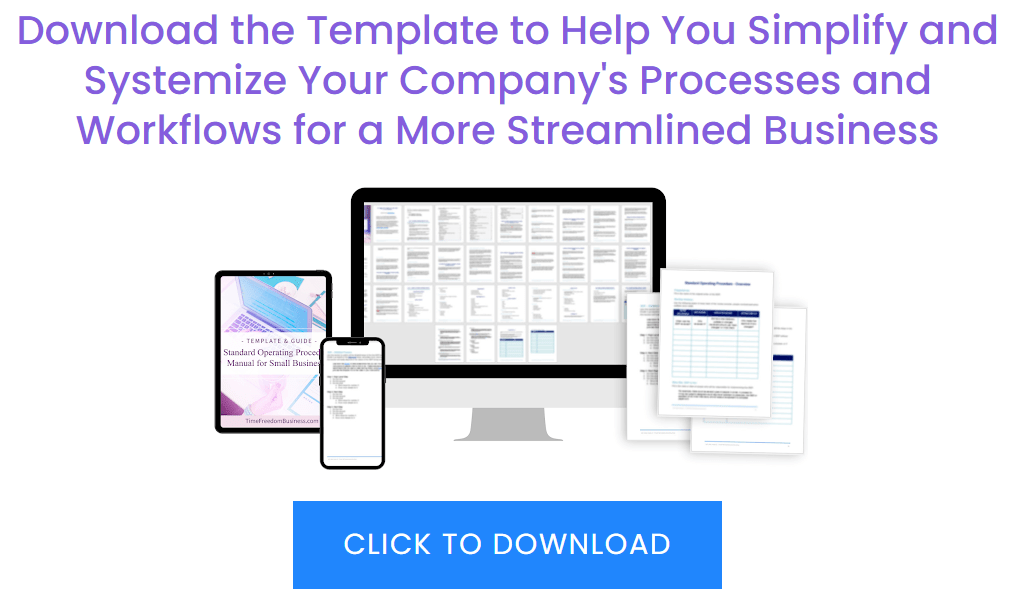Every entrepreneur knows that wasting her time and duplicating her efforts is a massive mistake.
But fewer of us realize how much wasted time and duplication may still affect our virtual teams!
Even if we’re no longer repeating tasks, our virtual assistants and other team members may be forced to, especially if we haven’t implemented streamlined operations systems.
See what I’m driving at, here?
Operational systems aren’t exactly thrilling or sexy to set up, but dang, can they ever improve your business.
They can make everything you and your team undertake more streamlined, more productive, and ultimately more profitable.
Plus once these systems are in place, certain elements of your business can run themselves, giving you more time to focus on the more creative and labor-intensive elements.
(They might even make it possible for you to take that vacation you’ve been needing …)
Ready to learn how to operationalize your business? Let’s do this!
Step 1: Identify Your Operations Activities
Before you begin creating systems, you need to list out all the tasks and workloads that make your business run. This includes both Direct Money Tasks and Indirect Money Tasks.
Direct Money Tasks can be linked to traceable, trackable income.
Think about getting on the phone with a potential client and closing a sale:
The money might not be in your hands immediately, but it’s on the way. These are the tasks that bring in revenue quickly and directly and are difficult to automate.
The slow-burn work that won’t generate revenue in the immediate future? Everything under that heading is an “Indirect Money Task.”
Think about posting blog content with a call to action.
Someone could find your blog post, read it, sign up for your list, and eventually become a customer. Money will come your way, but it might take months or even years to arrive!
If a task can potentially lead to money but takes a longer route, it can typically be automated, systematized, entrusted to a virtual assistant, or some combination of those!
Make a comprehensive list of both Direct and Indirect tasks so you can see the entirety of what’s keeping your business afloat.
Step 2: Subdivide Each Activity
Once you’ve got the complete list of high-level tasks created, you need to break them down into their component parts.
For any tasks that have a shot at being operationalized, break it down according to:
- Process: list out step-by-step actions, consulting team members for any details you don’t know yourself
- Tools: note anything required to complete the activity including software, equipment, instruction materials, or access codes/passwords
- People: codify the person/s in charge of each component of the task
- Strategies: the tips or techniques you use to execute this task fully and consistently
Doing this will help you figure out which tasks are repetitive and ripe for improvement!
Step 3: Streamline and Improve
Now comes the fun part! (OK, fun is relative, but this is where you get to make some real progress.)
Ask yourself what you want your operations systems to do for you.
Do you want to save time? Save money? Eliminate overlapping tasks?
You can have multiple goals, but my advice is to start with just one to keep yourself focused. Why?
Because this is when you streamline your process and determine what you can:
- Delete
- Defer
- Automate
- Delegate
- Consolidate
If you’re evaluating your tasks for saving time, you may opt to delegate adding CTAs to your blog posts … but if you’re evaluating tasks to save money you might choose to defer that same task!
Run through your lists once for each goal, then compare and rank by priority.
Step 4: Track and Test
Now, you have to PROMISE me that you’ll test out your system.
If you make all of these systemic changes and don’t measure whether your system is working properly or not, you’ve wasted your efforts.
Measurement can be as simple as estimating the time it took to complete a workload before and tracking how long it takes afterward.
Take our example of adding CTAs to blog posts: If someone was doing this manually before and you figure out a way to run search/replace functions instead, you can compare times and see an immediate improvement!
Step 5: Refine and Improve
Now that you’ve tested your system, it’s time to evaluate its effectiveness.
Improvements in time and cost are great benchmarks, but operations systems need to go beyond savings. So ask yourself:
- Did the system solve a problem?
- Is it easy to replicate?
- Did you see drastic improvements or just incremental ones?
- Is it worth using this system, or should you start over again?
Don’t be discouraged if your first attempt to create operations systems doesn’t totally transform your entire business.
There is no one-size-fits-all operating system, and it may take a few iterations to understand what works best for you and effectively streamlines your work.
If the first system doesn’t work as well as you thought, you can start again.
Creating any type of system takes quite a lot of thought, work, and refinement. But, when done properly, your proven operations systems can be one of your most valuable assets!








